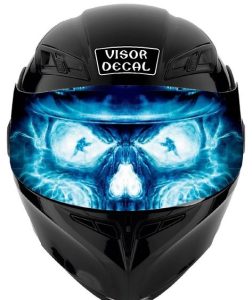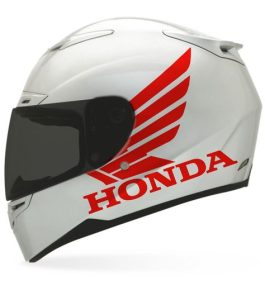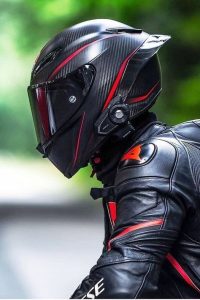May 11, 2024
Gearing Up: A Guide to Different Types of Motorcycle Helmets
Motorcyclists come in all shapes and sizes, and so do their riding styles. Choosing the right helmet is crucial for safety and comfort on the road. This article explores the different types of motorcycle helmets available to riders.
Safety First: Understanding DOT Certification
Before diving into specific helmet types, it’s important to understand the importance of safety certifications. Look for a helmet that meets the U.S. Department of Transportation (DOT) Federal Motor Vehicle Safety Standards (FMVSS 218). This ensures the helmet meets minimum requirements for impact protection. Some riders choose helmets that meet Snell Memorial Foundation standards, which are typically more stringent than DOT standards.
Different types of motorcycle helmets
Now, let’s explore the most common types of motorcycle helmets:
Full-Face Helmets:
Offering maximum protection, full-face helmets cover the entire head, face, and neck. They feature a visor that shields the rider’s eyes and a chin bar that protects the jaw. Full-face helmets are ideal for riders who prioritize safety and protection, especially for highway riding or long journeys.
Modular Helmets:
Modular helmets, also known as flip-up helmets, offer the versatility of a full-face helmet with the convenience of an open-face helmet. The chin bar can be flipped up and out of the way, allowing the rider to eat, drink, or talk easily while stopped. Modular helmets provide good protection, but some riders find them slightly heavier than traditional full-face helmets.
Open-Face Helmets (3/4 Helmets):
Open-face helmets, also known as 3/4 helmets, expose the rider’s face from the brow down. They provide protection for the head and back of the head, but leave the face vulnerable. Open-face helmets are popular for short rides around town in warmer weather due to the increased airflow, but safety experts recommend full-face helmets for maximum protection.
Half Helmets (Skullcaps):
Half helmets, also known as skullcaps, offer minimal protection, covering only the top of the head. Some riders choose them for their comfort and unrestricted airflow, but they are not recommended by safety experts due to the lack of protection for the face and jaw.
 Dual-Sport Helmet:
Dual-Sport Helmet:
Dual-sport helmets are designed for riders who enjoy both on-road and off-road riding. They feature a hybrid design that combines the features of off-road helmets, such as a visor and extended chin bar for protection against debris, with the aerodynamics and comfort of street helmets. Dual-sport helmets offer versatility and are suitable for a wide range of riding conditions.
Off-Road Helmet:
Off-road helmets, also known as motocross or dirt bike helmets, are specifically designed for off-road riding conditions. They feature a distinctive angular chin bar and an elongated visor to protect the rider’s face from flying debris and branches encountered on trails. Off-road helmets are lightweight and offer excellent ventilation, making them ideal for intense riding sessions in hot and dusty environments.
Bluetooth Helmet:
Bluetooth helmets are equipped with built-in Bluetooth technology, allowing riders to stay connected while on the road. These helmets feature integrated speakers and microphones that enable hands-free communication, music streaming, and GPS navigation. Bluetooth helmets offer convenience and connectivity for riders who enjoy staying connected without compromising safety.
Racing Helmet:
Racing helmets are designed for competitive racing and track use, prioritizing aerodynamics, stability, and maximum ventilation. They feature a streamlined profile, aggressive styling, and advanced aerodynamic features to reduce drag and enhance performance at high speeds. Racing helmets often incorporate lightweight materials such as carbon fiber for optimal strength-to-weight ratio.
Vintage Helmet:
Vintage helmets evoke the nostalgia of classic motorcycle aesthetics while incorporating modern safety features. These helmets feature retro-inspired designs with timeless styling cues such as chrome accents, leather trim, and vintage graphics. While vintage helmets may prioritize style, they still meet modern safety standards to provide adequate protection for riders who appreciate classic motorcycle culture.
Choosing the Right Helmet for You
The best helmet for you depends on your riding style, preferences, and climate. Here are some factors to consider:
-
Riding Style: Consider how and where you will be riding. Highway riders and those who value maximum protection might choose a full-face helmet, while casual riders who prioritize comfort in warmer weather might opt for an open-face helmet.
-
Safety: Safety should always be a top priority. Full-face helmets offer the most protection, while half helmets offer the least.
-
Visibility: A good helmet should provide good visibility with a clear, unscratched visor or shield. Tinted visors may not be suitable for low-light conditions.
-
Comfort: The helmet should fit snugly but comfortably. A loose helmet can move around in a crash, reducing protection. A helmet that is too tight can be uncomfortable and lead to headaches.
-
Ventilation: Consider the climate where you will be riding. Some helmets offer adjustable vents for better airflow in hot weather.

Choosing the right motorcycle helmet is an important decision. By understanding the different types of helmets available and considering your riding style and needs, you can select a helmet that provides both safety and comfort on the road. Remember, the safest helmet is the one you will always wear.
Additional Factors to Consider When Choosing different types of motorcycle helmets
-
Noise Reduction: Some helmets are designed to be quieter than others. This can be an important factor for riders who spend a lot of time on the highway or who are sensitive to noise.
-
Weight: Helmets come in a variety of weights. A lighter helmet can be more comfortable for longer rides, but some lighter helmets may offer less protection.
-
Extra Features: Some helmets come with additional features, such as built-in sun visors, communication systems, or hydration bladders. Consider which features are important to you.
Getting the Right Fit
A properly fitting helmet is essential for safety and comfort. A helmet that is too loose can come off in a crash, and a helmet that is too tight can be uncomfortable and cause headaches. Here are some tips for getting the right fit:
- Measure your head before you go shopping for a helmet.
- Try on several helmets in different sizes to find one that fits snugly but comfortably.
- The helmet should not move around when you shake your head.
- The cheek pads should feel snug but not constricting.
- The visor should seal against the eyeport to keep out wind and debris.
Remember: If you are unsure about the fit of a helmet, err on the side of caution and choose a smaller size. A helmet can always be stretched slightly for a better fit, but it cannot be shrunk.

Conclusion
Choosing the right motorcycle helmet is an important decision. By understanding the different types of helmets available, considering your riding style and needs, and getting a proper fit, you can select a helmet that provides both safety and comfort on the road. Always prioritize safety when making your decision.

